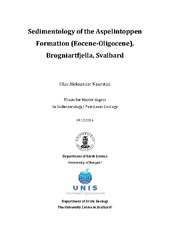| dc.contributor.author | Naurstad, Olav Aleksander | eng |
| dc.date.accessioned | 2015-01-27T13:54:40Z | |
| dc.date.available | 2015-01-27T13:54:40Z | |
| dc.date.issued | 2014-12-09 | eng |
| dc.identifier.uri | https://hdl.handle.net/1956/9286 | |
| dc.description.abstract | The following study investigate the vertical changes in fluvial channel and interchannel geometry and facies architecture of the Aspelintoppen Formation in the Cenozoic Central Basin on Svalbard. Sedimentary structures was predominantly developed by unidirectional traction currents. The channelized sandstone bodies are ribbon shaped and is characterized by low sinuosity. This architecture was promoted by cohesive banks that limiting lateral accretion and resulted in channel fill dominated by vertical aggradation of dunes and bars. The studied section shows a clear dominance of interchannel sheet sandstone and laminated mudstone deposits, which volumetrically comprises five times as much deposits as fluvial channels. Abundance of leaf imprints, roots traces and ichnotaxa assemblages of the Scoyenia and Mermia ichnofacies, indicates lateral extensive and highly vegetated swamps, and ephemeral lakes, which are suggested to be flooded for longer periods of time. Evolution of the sedimentary infill is best explained by high floodplain aggradation and shifting of main channel segments triggered by base-level changes, resulting in channel avulsion. Aggradational rates are reflected by the high degree of channel avulsion and large thickness of vertically connected crevasse splay complexes. Syn-tectonic deposition during uplift of the West Spitsbergen fold-and-thrust belt and foreland basin subsidence promoted a relatively high gradient of the fluvial system, resulting in great volumes of sediments being transported to the floodplain and bypassed to the basin. Base-level changes favourable for avulsion of major channel segments (trunk and major distributary channels) is subsequently promoted by high floodplain aggradation and possibly by sea-level rise, influencing distal parts of the fluvial system and/or by high stream flow breaching channel banks, redirecting the channel to a more preferred location. Characteristics of the studied succession points to a sedimentary basin with high sedimentation rates and subsidence which would promote the high aggradational rates suggested for the fluvial system of the Aspelintoppen Formation. | en_US |
| dc.format.extent | 29793916 bytes | eng |
| dc.language.iso | eng | eng |
| dc.publisher | The University of Bergen | en_US |
| dc.subject | Geologi | nob |
| dc.subject | Svalbard | nob |
| dc.subject | sedimentologi | nob |
| dc.title | Sedimentology of the Aspelintoppen Formation (Eocene-Oligocene), Brogniartfjella, Svalbard | en_US |
| dc.type | Master thesis | |
| dc.date.updated | 2015-01-27T13:51:01Z | |
| dc.rights.holder | Copyright the author. All rights reserved | en_US |
| dc.description.degree | Master i Geovitenskap | en_US |
| dc.description.localcode | MAMN-GEOV | |
| dc.description.localcode | GEOV399 | |
| dc.subject.realfagstermer | http://data.ub.uio.no/realfagstermer/c030202 | |
| dc.subject.realfagstermer | http://data.ub.uio.no/realfagstermer/c013425 | |
| dc.subject.realfagstermer | http://data.ub.uio.no/realfagstermer/c011646 | |
| dc.subject.nus | 756199 | eng |
| fs.subjectcode | GEOV399 | |
